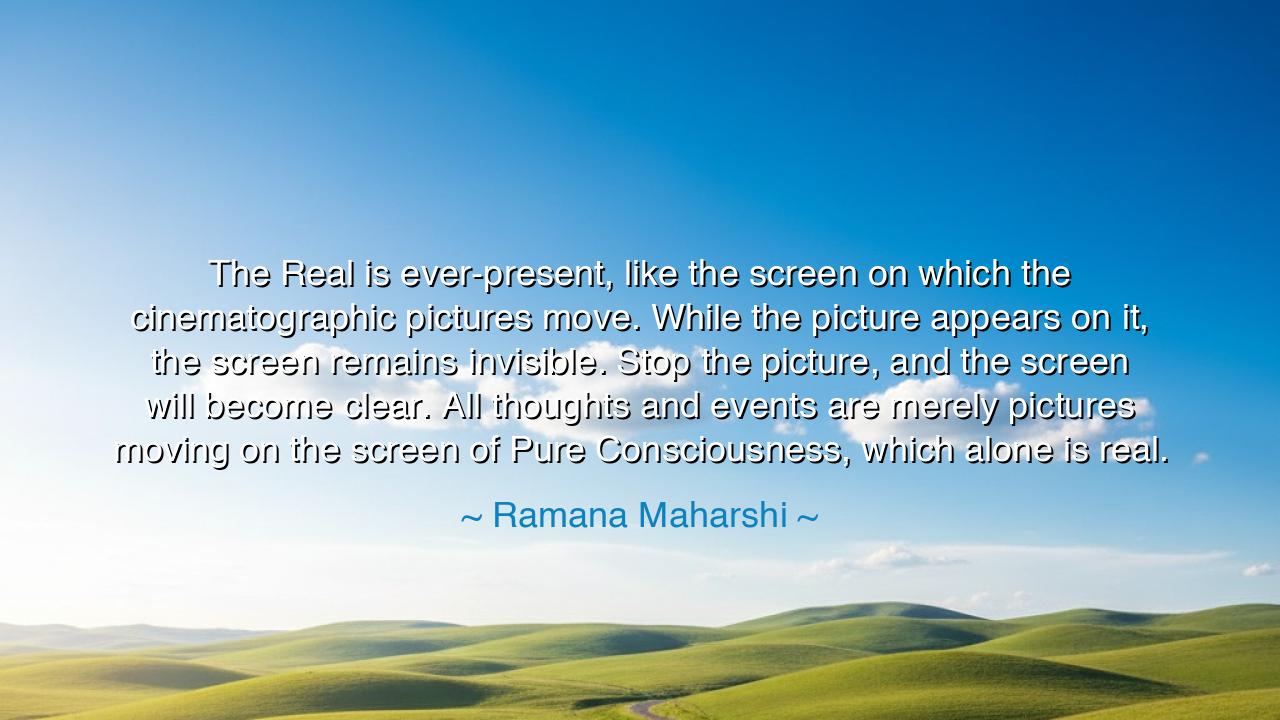
The Real is ever-present, like the screen on which the
The Real is ever-present, like the screen on which the cinematographic pictures move. While the picture appears on it, the screen remains invisible. Stop the picture, and the screen will become clear. All thoughts and events are merely pictures moving on the screen of Pure Consciousness, which alone is real.






In the luminous words of Ramana Maharshi, the sage of Arunachala, he said: “The Real is ever-present, like the screen on which the cinematographic pictures move. While the picture appears on it, the screen remains invisible. Stop the picture, and the screen will become clear. All thoughts and events are merely pictures moving on the screen of Pure Consciousness, which alone is real.” In these few lines, the Master unveils a mystery that countless philosophers and seekers have tried to grasp — the nature of Reality and the illusion of the world that veils it. What Maharshi offers is not philosophy, but direct insight — a vision of truth that dissolves illusion like light scattering darkness.
When he speaks of “the screen”, he refers to the Self, the unchanging awareness that lies beneath all appearances. Just as a film unfolds upon a motionless white screen, the world, with its joys and sorrows, plays out upon the field of consciousness. The actors, the landscapes, the storms and celebrations — all arise, move, and fade, yet the screen remains untouched, unstained, eternal. Most people, Maharshi says, are absorbed in the film; they weep, rejoice, and fear as though the story were real. Yet the wise one turns inward and sees that what changes cannot be the Real, and what remains beyond all change is the only truth.
The origin of this teaching lies in Maharshi’s profound enlightenment experience at the age of sixteen, when he faced death and asked, “Who am I?” In that silent inquiry, he realized that the body may perish, but the awareness that witnesses life and death never dies. From that moment, he became one with Pure Consciousness, seeing the world not as solid matter, but as shimmering reflections upon the eternal screen of Being. He taught that the universe is maya — not false, but fleeting, a play of appearances upon the substratum of the Self. The purpose of life, he said, is to awaken to this truth — to cease identifying with the moving pictures of thought, emotion, and form, and to rest in the stillness that underlies them all.
Consider the tale of Prince Siddhartha, who became the Buddha. Surrounded by splendor, he lived within the picture — the grand illusion of pleasure and permanence. But when he saw suffering — old age, sickness, death — the image began to dissolve. He turned inward, renounced the palace, and sat beneath the Bodhi tree until the “film” of ignorance ceased to move. In that silence, he saw what Maharshi also saw: that the Real is beyond birth and death, beyond time and mind. Like the screen, it is ever-present, unchanging, yet it gives rise to all appearances. The Buddha called it Nirvana; Maharshi called it the Self — different names, one truth.
Maharshi’s metaphor of the cinematographic screen is deeply compassionate, for it shows that life’s drama is not to be despised but understood. The film itself is not evil; it is art — the divine play of creation. The problem arises only when we forget the screen beneath it. When we identify with the fleeting pictures — with our body, possessions, and stories — we suffer, for these images fade. But when we know ourselves as the awareness on which all appears, we find peace that no event can disturb. Joy and sorrow become like clouds passing across a boundless sky. The wise, Maharshi said, are those who live in the world but are not of it — who watch the film without losing sight of the screen.
To live this truth requires not belief, but direct inquiry. Maharshi’s path was simple yet profound: ask yourself, “Who am I?” When thoughts arise, trace them back to their source. When desires pull you outward, turn inward and find the one who desires. As you peel away layers of identity — body, mind, name, and role — what remains is pure awareness, luminous and silent. This is the screen upon which all things appear. To know it is to awaken; to forget it is to sleep.
Let this be the teaching: cease chasing the pictures, and learn to rest in the stillness behind them. Do not fear the changing scenes of life — they are shadows dancing on the eternal. When pain arises, remember: the screen is untouched. When joy comes, enjoy it, but do not cling — for the screen abides when the scene fades. Practice stillness, self-inquiry, and presence, and you will begin to sense the quiet radiance of your true nature.
Thus, the wisdom of Ramana Maharshi resounds through the ages: that all things are fleeting, but the Real is forever. You are not the image that moves, but the light by which it is seen. When the film of life ends, the screen remains — vast, pure, and eternal. Know that screen as yourself, and you will know peace that no shadow can disturb, and joy that no ending can erase.






AAdministratorAdministrator
Welcome, honored guests. Please leave a comment, we will respond soon